We are travelling gradually south in this series covering the styles of the finest tailors in the world.
So having covered the major styles of London, we arrive in Paris – which is all close chests, roped shoulders and ornate finishing.
Now, the major French tailors like Cifonelli and Camps de Luca owe much of their heritage to Italy. But that was over 50 years ago, and in that time the French have developed enough of a style to be distinctive.
It’s most obvious in the finishing, just because they do it better than anyone else. Not just the amount of handwork, but its precision – the neat Milanese buttonholes, the number of pick stitches to the inch.
But the tailors have more subtle points in common too, such as a clean chest and a prominent sleevehead – which puts a full stop to the end of the shoulder.
We begin with this grey end-on-end suit, from Camps de Luca.
House: Camps de Luca
Address: 16 Rue de la Paix, Paris
Site: campsdeluca.com
Cutter: Marc de Luca
Price of suit (at time of writing): €6800 (incl VAT)
The suit was cut for me in 2014 by Marc de Luca, with fittings done both with Marc and Julien.
It was a heavy cloth for them, at 13 ounces, in a very professional-looking mid-grey but with some nice surface detail through the pick-and-pick weave (‘sharkskin’ in the US).
It is two-button, with grey mother-of-pearl buttons and shallow turn-ups (4cm) on the trousers.
The style is more distinctive than you might think, with the thick sleevehead and characteristic fish-mouth style gorge (the lapel angles up slightly, making it halfway between a notch lapel and a peak).
Initially I wasn’t sure about those style points, but over time the suit has grown on me, and I am very fond of it now. A great option for a business suit, in fact: serious yet full of character.
Interestingly, that wide sleevehead is not achieved through a lot of sleevehead wadding, but by extending the shoulder pad slightly into the top of the sleeve.
Which technique a tailor uses makes little difference to the overall effect, except that sleevehead wadding is able to make the sleevehead higher as well as wider.
Whether you think a prominent sleevehead like this makes the wearer seem broader or not is slightly subjective.
To my eye, it rather stoppers the shoulder and prevents the eye travelling to its full width. To others, it makes the shoulder look wider by drawing the eye to the ends.
Both Camps de Luca and fellow Parisians Cifonelli use a wide sleevehead like this, although Cifonelli also cuts a rather wider shoulder (6½ inches, compared to 5¾ inches on this Camps suit).
The shoulder pad itself is moderate: not as thick as most English, but thicker than Neapolitans. And the line from the sleevehead down into the chest has a slightly inwards cut.
The lapel is not that wide, despite the fish-mouth shape pushing out its width (3⅝ inches) and it has a fair amount of belly, like most English single-breasted lapels.
Everything else is also moderate. A moderate gorge position (not too high, not too low); moderate shaping through the waist; and moderate quarters, opening up just slightly towards the bottom.
In the side-on image above, you can see how that sleevehead makes the top of the sleeve quite large and prominent – and exaggerates the effect of what is quite a slim sleeve.
Interestingly, though, the cuff is not that slim. The sleeve even appears to flair out slightly towards the bottom, though that is just the visual effect of less taper than normal.
The jacket a little shorter than most English suits (as are most French) at 31 inches, and the buttoning point a touch higher than either English or French.
We’re deliberately not talking about fit in these posts, as the focus is on style. Plus, static photos are always a poor way to analyse fine points of fit.
That said, the back on this suit is really beautiful and clean, and only a touch restrictive.
In the image above, you can also just see the effect of the characteristic Camps vents: they have a large amount of overlap that is pressed back inside, making the vents look more like pleats.
There is pick stitching everywhere on the suit by the way – on almost every seam – but even close-up shots would struggle to show it as the stitches are hidden by the textured cloth.
The buttonholes are also beautiful and neat (‘the best I’ve ever seen’ in one tailor’s words).
The buttonhole in the lapel is rather small though: more like an Italian size and a point of difference from Cifonelli or Smalto.
The turn-ups on the trousers are narrow at 4cm, which reflects the time this suit was commissioned: before I had most of my trousers with turn-ups and had settled on a size I liked (5cm). It’s not a point of house style.
Arguably this suit would look better without turn-ups anyway, given its relative formality, and I might have them taken off at some point.
I have a weakness for black-suede shoes with grey suits. They suck up the light wonderfully, and are subtly unexpected.
These are from Edward Green, while the cream tie with a small green-and-brown geometric pattern is from Anderson & Sheppard. The tonal whole feels formal, yet dandyish at the edges.
By the way, readers have commented that these suits don’t look as good as in the ‘lifestyle’ pictures they were originally reviewed with. (See Camps example here.)
To an extent, that’s the point. In this series the suits are stripped bare and under harsh light, for precision and consistency.
Most lifestyle images (much more common on websites and of course on Instagram) never really expose or examine suits in the same way. (Particularly by pressing them just before wearing – and then standing just so.)
So if anything, these suits look better in person – and I’ll continue to post those kind of images in other posts for greater context. Just not here.
Style breakdown
- Shoulder width: 5¾ inches
- Shoulder padding: Moderate
- Sleevehead: Strong roping
- Sleeve: Slim, no taper to cuff
- Lapel: 3⅝ inches, fish-mouth style (closed notch)
- Gorge height: 4 inches
- Drape: None
- Outbreast pocket height: 10⅜ inches
- Buttoning point: 18¼ inches
- Waist suppression: Moderate
- Quarters: Quite closed
- Length: 31 inches
- Back seam: Quite straight
- Vent height: 11 inches
- Trouser circumference at knee: 20¼ inches
- Trouser circumference at cuff: 17 inches
Photography: Jamie Ferguson @jkf_man


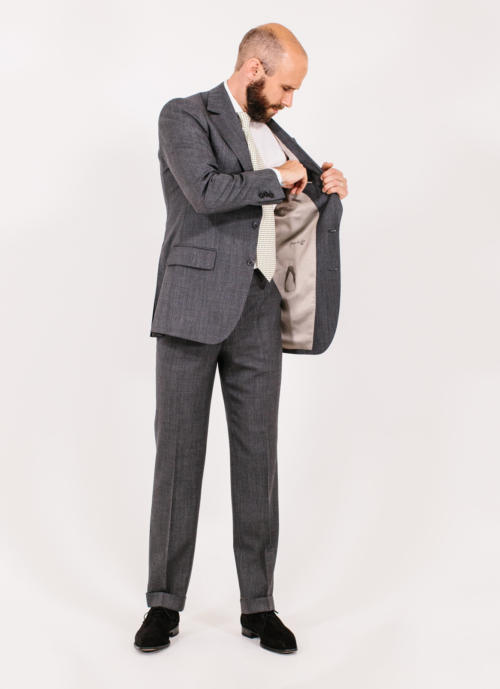
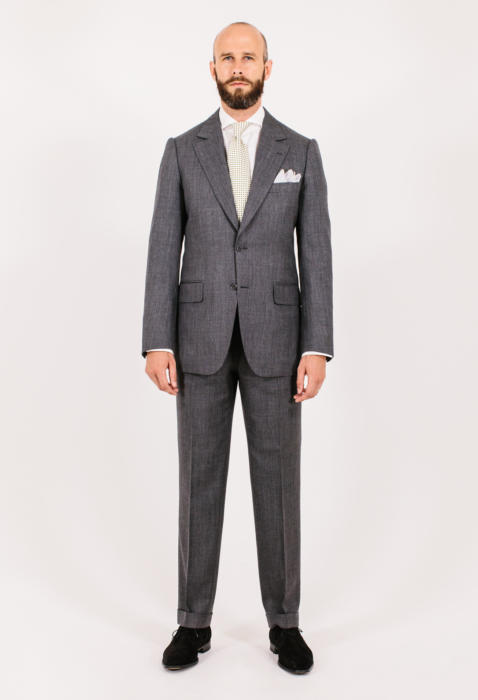
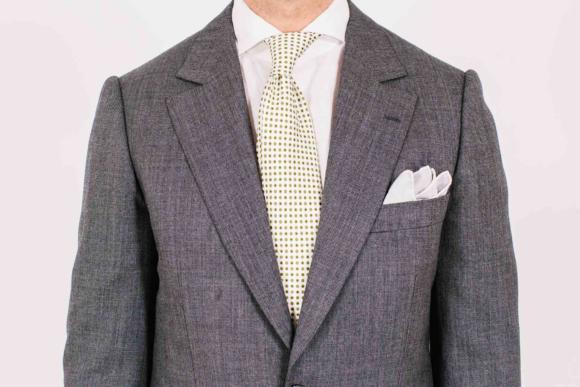
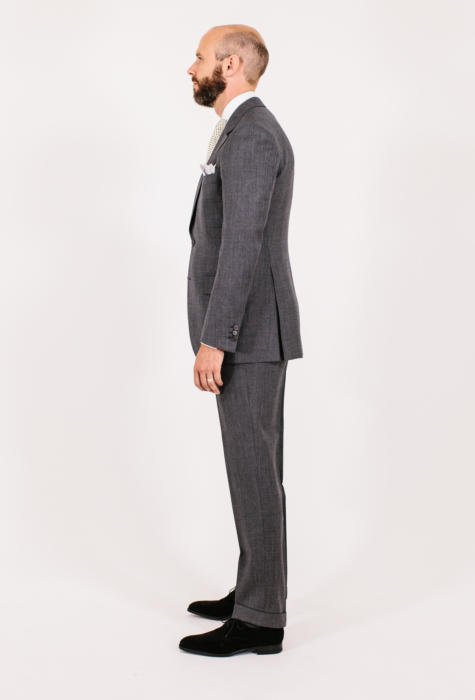
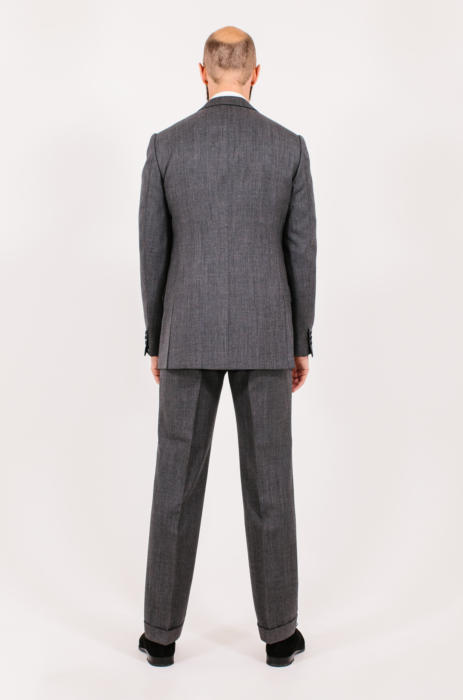
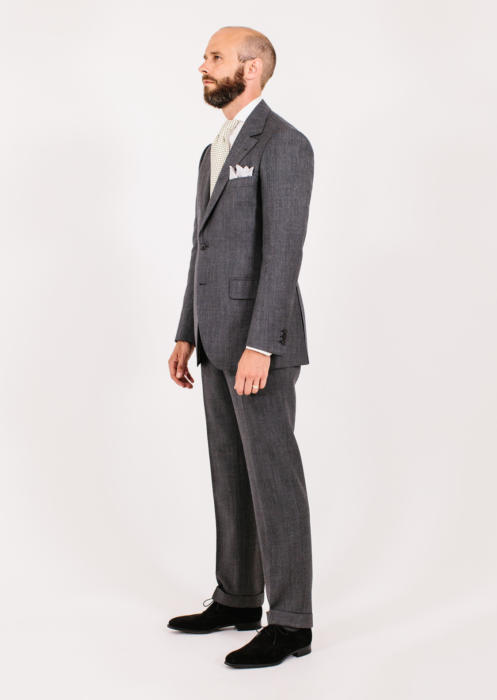
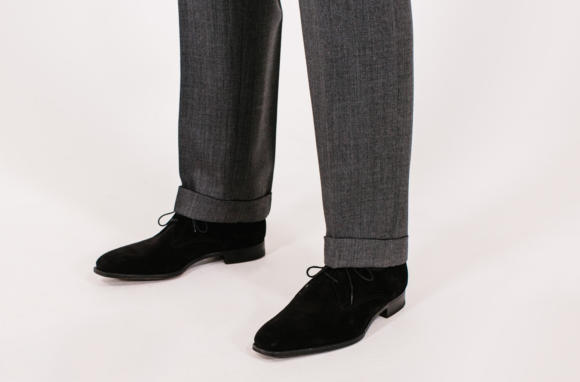
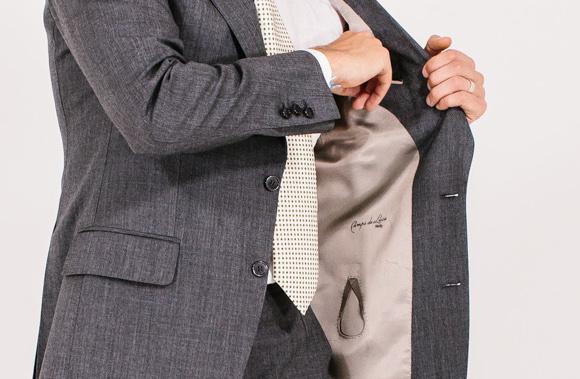


























Simon, I hope you won’t mind me mentioning that you’ve described your seat as “prominent” before. I have the same issue, and found that a centre vent works best at minimising the prominence, or even no vent where possible (on my dinner jacket and some DBs). Do you reckon the Camps way of doing side vents also works well?
I think it does work well, yes, though to be honest I find the centre vent the worst solution, as it will most obviously start opening, where the side vents are more subtle (and any work is split between two of them). Why do you find the centre vent works well?
Because one vent emphasises the seat less than two, and because the jacket’s skirt retains more of its own shape; but maybe you’re right, and in the end there’s only so much tailoring can do.
Thanks. I guess the vent always seems to open, but then I’ve never actually had a single vent on a bespoke jacket (preferring two vents from a style point of view as well)
Hi Simon,
Could you elaborate a little on what you mean by a “clean” chest? I’m obviously not expecting to see any ripples or folds of cloth on a bespoke suit, and haven’t seen them on the other suits reviewed so far. Do you mean that the chest is cut quite close to the body? If so, I take it that it is cut even closer than a structured English suit?
Thanks for clarifying.
Yes, a clean chest is a way of saying there is less drape, which can of course have some ripples or folds as a result of the extra material.
It is a little closer than most English structured, yes, more similar to most Neapolitans
16 Rue de la Paix, London?
Closer to home than I thought 😉
Oh dear… and I used to be such a good proof-reader. Thanks, I’ll amend now
Simon
Sorry to post here but didn’t know where else to go! Is there anyone you can think of who is really adventurous and would think about trying a technical fabric they haven’t used before? I am thinking about a tweed overcoat with either gore-tex or kevlar lining (dependent on use…)
I know tailors aren’t trained in the proper seams etc but any thoughts on who might be brave enough to try?
Not particularly sorry. It’s less about adventurous spirit and more about who actually might have the right machinery, or have any experience there.
Understood, thanks. If you ever hear anything please do post about it!
Will do
https://www.rusteprotection.com/
Have we gone mad?
There are so many things wrong with this I don’t know where to start.
Goretex will eventually crack and flake, and there’s no way you’ll ever scrape all the fragments off your precious tweed so you can have it relined.
You’ll lose the drape on your tweed.
Tweed is wool: once it’s soaked, your precious Goretex becomes useless.
And if you counter with the remark that maybe it won’t rain that hard, then why do you need Goretex at all?
Oh, and how exactly will your tailor press your coat with the Goretex on?
I want to keep dry when shooting
No Tailor is going to touch this. My iron ramps up to 150c I never use it at that temperature but it would be impossible to underpress the garment you describe. By a ready made it will be better!!!
It might be worth having a word with Alexander James in Manchester:
http://www.alexander-james.co.uk
They aren’t proper bespoke tailors, but do good MTM and have the equipment to put a GoreTex-type liner inside a tailored coat. They made a hunt coat for me in 2012 which fits very well (and I have suits made by Huntsman and Battistoni, so have a decent standard to compare the fit), with a technical lining which works perfectly and keeps me dry for a whole day out on the hill in West Wales.
Being impressed with the hunt coat, I ordered two MTM (they called it ‘bespoke’) suits which were a disaster. They accepted this and didn’t ask me to pay for the work done.
If you can find a design of shooting coat which is close enough to a block they regularly use, they will be able to make it fit you in any tweed you like, with a proper waterproof lining. Don’t try to be more adventurous!
Nice suit; do most English tailors make the afore mentioned breast line outward? Is it purely a consequence of their shoulder line being extended?
– just to make sure, the price is 2018 or 2014?
Yes, 2018
A very nice suit but you keep slipping back into the Royal ‘we’. In this piece, you start with ‘we’ and end with ‘I’. Given that you are the only one wearing the suit, ‘I’ seems more appropriate.
Thanks for your view Philip, but I don’t think it really matters. And sometimes there is more than one person involved (eg here myself, Jamie and a tailor are working together on the series)
I’m failing to see the problem here. You can construe the use of ‘we’ in Simon’s opening preamble to refer to the readers as well as Simon; we are joining him on this journey, after all. Throughout the rest of the piece he is either discussing his history with commissioning the suit, how it is constructed and his opinions of it, at which point a switch to using the first person singular ‘I’ makes perfect sense.
Who knew a website devoted to style minutiae would attract grammar and syntax pedants!
What do you think of a cable stripe pattern on a charcole cloth
Probably a little showy I think….
Simon, good evening.
It is undoubtedly a beautifully made suite. As you rightly the say the finish is second to none. However, when comparing it to your more recent flannel suit from Panico, it lacks the “wow” factor. In fact, I would go as far as to say the latter is simply more elegant. A very specific plus to the Panico is the pleated trousers.
If I could mug you for one of your suits it would this one. Fear not, I am a 42 chest so your quite safe!
Philip.
Regarding grammar and syntax: Simon’s response is correct. However it is no surprise that this subject arises as it does. Those that are able to afford bespoke are usually well educated. Furthermore those with an eye for the minutiae of bespoke may, understandably, also have an eye for the finer points of language and writing style. I like Simon’s style and more importantly his approach to discourse. The comment wasn’t mine but I understand that sometimes it’s made just for fun (similar to debating inference vs. implication) rather than pedantry. Simon is well educated and hopefully sees such comments more as an in-joke (by would be grammarians) rather than a criticism or insult.
I do, certainly. I don’t see them as insulting.
They can be a little distracting for other readers, however, who would rather have interesting comments about quality or style to read. I’d generally prefer to stick to those therefore.
I think the pronoun issue is an interesting one because of the blog format. ‘Permanent Style’ is synonymous with one man, Simon Crompton, and so the blog’s audience might naturally expect the ‘I’ in the articles to pertain to that one man. When ‘we’ is used, the average reader might be a little confused because the aforementioned expectations are being confounded slightly. This would not be so on a website with a rotating cast of writers whose identity is unimportant.
Also, different readers come to the site for different reasons; I come because I am interested in the clothes themselves, but also because I enjoy Simon’s writing style, and because I enjoy following Simon’s sartorial journey over time — vicariously, because I could not afford to take such a journey myself! Therefore, I like reading slightly off-topic comments, such as those about grammar, and view such things as amusing, interesting, and part of the charm of the site. As long as the comments are respectful (and appreciative of Simon’s hard work), I don’t see a problem.
Simon, I think it is one of the advantages of your site that readers can speak for themselves and the fact that this pronoun issue has been brought up repeatedly by different people (in a perfectly polite manner) makes it relevant for at least some readers. Let´s not forget that there has also been room for discussing your favourite records. I for one could´t agree more with the comment above.
Thanks Martin
Simon,
How do you measure shoulder width?
From neck point (where collar seam and back seam meet) to the sleeve seam where the shoulder meets the sleevehead
Hi Simon – what do you think of suede shoes with blue suits? Is there any specific model or colour you would recommend?
I’m imagining them in a not “very formal” context with a blue suit with patch pockets and no tie.
Thanks!
Well, I’d almost never wear a suit without a tie, but I’d go for a dark brown suede – basically a brown that’s darker than the suit
Any take on the model?
Not really – most things would work, though I’d stick with fairly normal derbys or oxfords (rather than, for example, double monks)
You mention Milanese buttonholes. This should only ever be the lapel buttonhole, not all.
You also mention relativity of the shoulder width. This cannot be misunderstood; it can only be based on the dimensions of the wearer.
You mention the buttoning point being higher than the English and the French; CdL are French Simon.
This is not a fishmouth lapel; properly done, the lower edge of the notch curves upwards far more than this.
What are these comments supposed to represent to your readers?
Hi Adam
Your first point is a typo – that should say buttonhole. Thanks.
On shoulder width, yes on all these posts the width is relative to my shoulders. And given I have the same shoulders in every suit, it is instructive how large one tailor cuts a shoulder for me compared to another one.
The buttoning point could be clearer. I think it’s fairly obvious though that I mean compared to other French tailors.
This is what Camps and most French tailors call a fish mouth lapel. But there are of course degrees of it. Most significant, of course, is that the lapel angles up at all from the gorge line, where normal notches do not.
Thanks
Has a good visual presence, but dirty back scye, should have been controlled more .
13 oz, cloth, but which merchant Dormeuil ?
As always, I don’t think you can tell fit points from the images. Cloth details on the original posts
Simon,
Great write up.
How do you measure the back length. Along the center back seam up until the “fold” in the collar or to the bottom stitching on the collar?
Thanks,
S
Bottom stitching – where the collar is attached to the back
I don’t mind the turn-ups here — they are moderate enough to work unobtrusively.
But I don’t care for the high buttining point on the coat. It maks your upper seem shorter.
The cloth is very nice!
Simon always has the button point too high, but on this suit it is worse than usual.
There are of course no absolutes, no objectively too high or too low. However, in this case as with many early things I went with the house style. Today I might ask it to be a touch lower yes
I’ve said before that this suit is the best I have seen you wear. Sure it’s easy to pick faults but given that nothing is perfect you would be hard pressed to describe this as a compromise. On the issue of side vents the amount of cloth that CDL have left should be standard for all jackets but clearly the additional cloth required adds to the cost. Side vents are an easier option for a cutter to fit as the cloth finds it’s natural position. A plain back is less work for the tailor but are the most difficult to fit well. Center slits are better left for over coats were they fulfill a useful purpose..
Thanks, nice points. One note though – CdL put a lot more extra cloth in the side vent because they press it back, to give the impression of a pleat
Morning,
“is all close chests, …”
Is the suit an example of Frnch closed chest you would say? Is it representative of the house style?
Thanks!
Yes
I think I prefer Savile Row.
Hello Simon,
I don’t know if you’ve answered this question before but to what extent can a bespoke suit be altered for someone whose morphology/weight may change in the future? I understand it may be difficult to give a general answer. Are you still pleased with the fit of bespoke garments that you commissioned several years ago? I’m asking because I’m 22 and my upper body is growing due to sport (and food choices I have to say). Nothing close to extreme weightlifting though.
They can be changed, yes. Not a lot, but always more than ready made tailoring given the extra inlay at the seams.
Yes, I’m still happy with those suits. Again Ive changed a bit but as long as you don’t lose a huge amount off the waist or change physiognomy through weights etc, you’re usually fine
Philip wrote: “If I could mug you for one of your suits it would this one. Fear not, I am a 42 chest so your quite safe!”
Heh, got me thinking. I remember the grey flannel suit from Edward Sexton. That suit makes the world a so much better place every day. Would go for that one.
“I remember the grey flannel suit from Edward Sexton. That suit makes the world a so much better place every day. Would go for that one”.
Are you appoint to do a post on the Sexton suit as part of this series? And perhaps W&S and KHL?
I think that the Sexton suit is one of my favourites, the one I’d most like to own.
It will be part of it, yes, but not soon – we’re travelling through Italy next, then will loop back and fill in some gaps. Otherwise it would take us forever to get through all the main styles
Simon,
The suit is on you.
It’s properly conforms to your figure without needless frills very nice tailoring work.
Patrick
Simon,
Are the Edward Green black suede shoes the Chelsea model on the 82 last?
May I know what fabric it is? From which bunch ?
I’m considering it will be the choice of my second business suit (I have a crispaire charcoal already)
Hi Stanely – for more details, it’s always worth looking up the other coverage of the suit historically. In this case, the post here.
Holland & Sherry
Bunch Perennial N°1165
N°651717
100% worsted wool
400 gr
This bunch does not exist any more but it was replaced by the bunch Perennial Classic N°1564.
Hi Simon,
Great website. I’ve had look on the Holland & Sherry site, noting your point that the bunch was replaced by Perennial Classic N°1564. However it looks like the ref number of the cloth itself (651717) has also changed. I think I’ve found the replacement though but was wondering if you could possibly confim by taking a quick look:
https://apparel.hollandandsherry.com/en/fabric/use/suits/644015-perennial-classics-gray-sharkskin
Much appreciated!
That looks like it to me, but I’d suggest asking them specifically if there are any differences, as I haven’t seen that new cloth in person
Hi Simon,
Any experiences with Kenjiro Suzuki? How is his quality of work?
Best,
Bryan
It’s very good Bryan. We’re in the middle of making a cotton suit at the moment. From what I’ve seen so far I would certainly recommend his work
I love the mother of pearl buttons on this suit. For various different reasons, I have been skeptical of them. But here, they are quite understated and professional. Perhaps I should give them a go on a mid gray suit!
I think this is probably the only suit that I think they look good with. Something about mid-grey and the grey pearl. I think it might work because there’s no contrast between colour of button and suit – which would look odd in horn, but is nice where the shine of the pearl creates contrast with the matte wool.
Not sure you’re best placed to answer this, but for a close chest like this, do you know what the difference may be between your chest measurement, and the garment chest measurement. Then do you know what the difference may be between your chest and the garment chest measurement on a jacket with some drape in it. I’ve always wondered just how great the difference is between these styles in terms of measurements. Are we talking an inch or merely a few mm to create the drape?
I’m afraid I don’t know actually Jonny, but it is something I could try and measure at some point. It’s an interesting area